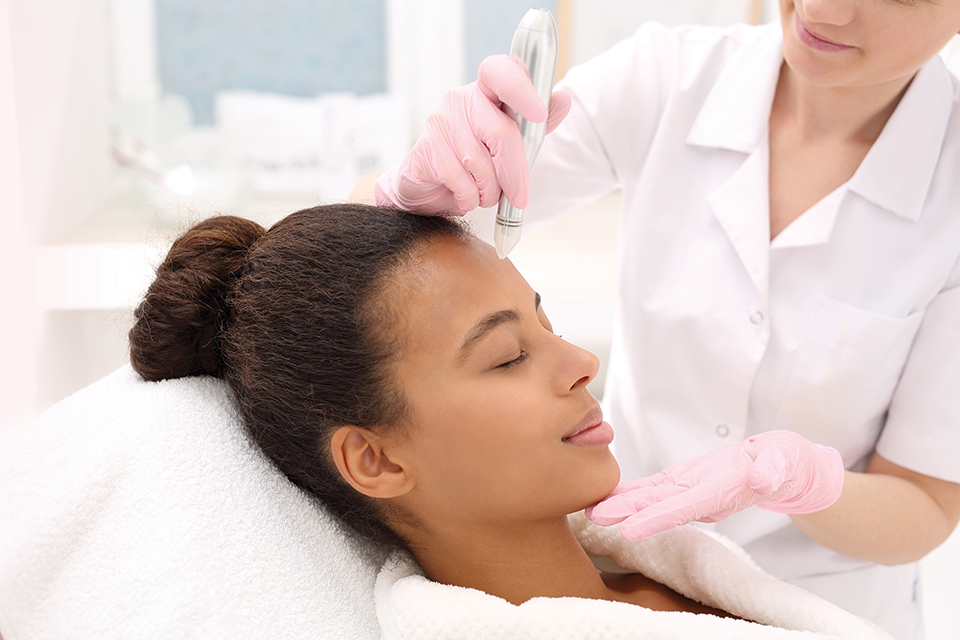Micro-What?

Needles? For your face? Yes, that is correct…and the outcome can be well worth it. As many of us grew up with the familiar phrase “beauty is pain,” we typically attribute those small discomforts to too-high-heels and the occasional, accidental burn from hair appliances. With tiny “micro” needles sticking out from a small, one-inch roller, microneedling is the latest beauty fad right now. However, its popularity isn’t just from its obscurity — it actually works. Even skincare professionals have utilized this out-of-the ordinary trend and have also begun offering versions of it as in-office treatments.
Now deemed the “dermaroller,” the microneedling utensil is used by being rolled over the face while its tiny needles sticking out from the roller puncture the skin, creating what is called “micro-trauma.” This micro-trauma stimulates collagen, which is a protein in the body, to rebuild under the skin. This slightly uncomfortable process can promote healing as well as the appearance of firmer, younger skin. Essentially, microneedling is beneficial for people who want to ease/get rid of acne scars, wrinkles, large pores and fine lines. While the process of microneedling is not too painful, it can be slightly uncomfortable for those with a low pain tolerance — but the results can end up outweighing the couple of minutes of discomfort.
“Each one of those little puncture wounds is a small micro-injury,” says Dr. Jessica Wright of Rejuvenate Austin. “What that does is each little micro-injury signals your body to get into the wound healing cascade, and that creates collagen and elastin.”
While at-home and in-office microneedling procedures can both be beneficial to the skin, Wright says that an in-office procedure is more productive since the professional devices are more effective at puncturing deeper into the dermis.
Dermarollers made for at-home use do work — however, they work in a “micro,” yet still helpful way.
“The difference is with a roller device at home, you’re going to get hundreds of little tears,” Wright says. “In the office, you’re going to get hundreds of thousands of very precise puncture wounds. Those precise puncture wounds are going to give you good collagen production.”
As dermarollers typically puncture the epidermis (the surface of the skin), Wright says at-home microneedling treatment can still be beneficial for helping skincare products, such as vitamin C serums, to be absorbed deeper into the skin. This deeper application of skincare products helps their efficiency, thus helping with a better, faster outcome than if serums were applied without the at-home dermaroller treatment.
According to Medical News Today, in addition to getting more of a result out of skincare products, using dermarollers at home will even “increase blood flow, which may temporarily brighten the skin.” Hello there, fresh-glowing, dewy skin.
Even though the demand for microneedling has increased significantly in the beauty and skincare industry during the last couple decades, Wright says, microneedling has been practiced for many years in other types of medicine, such as the use of microneedling on racehorses within veterinary medicine.
“I think microneedling has gotten a lot of buzz in the industry because it works and people see real results,” Wright says.
In addition to healing acne scars and reducing pore size, Wright says microneedling has seen a recent growth in microneedling procedures specifically to help reduce the width and appearance of stretch marks.
As she has clients of all ages, each person who comes into Wright’s office has different levels of collagen production. No matter who you are, as you get older, your collagen production slows down, which is why you lose elastin and develop wrinkles in your skin when you age. Luckily, microneedling helps get that collagen production you need to keep your skin looking young, firm and glowing.
The amount of in-office treatments one needs depends on genetics and lifestyle, and of course, age. Wright says she typically recommends her clients over 40 years of age to come in for a microneedling procedure four times a year for optimal results. For younger clients, Wright recommends only two or three a year, as younger people have quicker collagen production.
Scared to begin your microneedling experience in an office? Start at home and work your way up to professional procedures. Even though you will get more collagen production out of an in-office microneedling treatment, at-home dermarolling still has significant benefits and will still give you that fresh, daily glow.
Pro tip: If you are microneedling at home, make sure the utensil is clean and sterile. If it is not, you could be introducing more bacteria into your face which could end up resulting in more acne. Keep it clean and happy microneedling.






